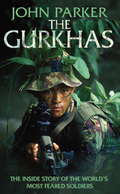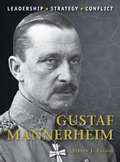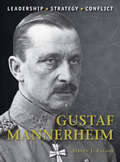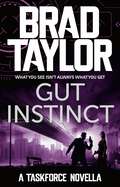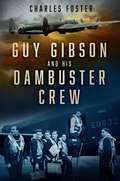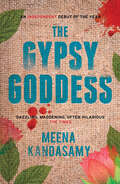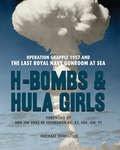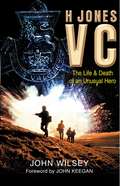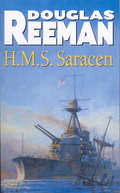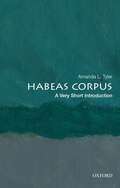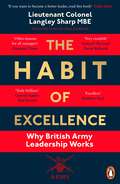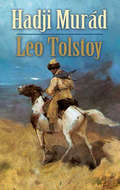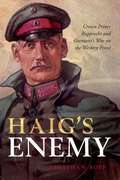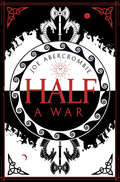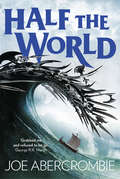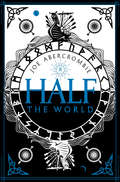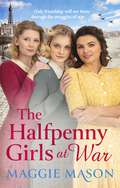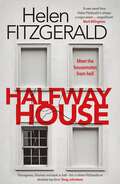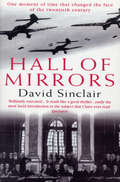- Table View
- List View
The Gurkhas: The Inside Story Of The World's Most Feared Soldiers
by John ParkerTheir ferocity is as legendary as their loyalty to the British Monarch and their regimental histories are crammed with acts of incredible bravery and sacrifice. Their reputation as fearsome fighting men remains undisputed and the mere threat of their kukri knives has put the fear of God into opposing forces throughout the world. John Parker's book is a fascinating testimony to the Gurkhas - a fighting force that stands dramatically apart in British military history.
Gustaf Mannerheim (Command)
by Steven J. Zaloga Adam HookCarl Gustaf Emil Mannerheim is a legendary figure, whose life and career were deeply influential in Finnish and European history. He is viewed by many as the father of modern Finland after leading the 'White' faction to victory and independence in the Finnish Civil War of 1918. He then commanded his country's forces in a sequence of bitter clashes in the ice and snow, in the build-up to, and during, World War II: the Winter War in 1939–40, the Continuation War in 1941–44 and the Lapland War in 1944–45. This study provides a fascinating insight into Mannerheim's career, analysing his traits, his biggest victories and his key enemies. Complete with uniform artwork and detailed tactical maps, it is a comprehensive guide to one of the 20th century's most capable military leaders and statesmen.
Gustaf Mannerheim (Command #32)
by Steven J. Zaloga Mr Adam HookCarl Gustaf Emil Mannerheim is a legendary figure, whose life and career were deeply influential in Finnish and European history. He is viewed by many as the father of modern Finland after leading the 'White' faction to victory and independence in the Finnish Civil War of 1918. He then commanded his country's forces in a sequence of bitter clashes in the ice and snow, in the build-up to, and during, World War II: the Winter War in 1939–40, the Continuation War in 1941–44 and the Lapland War in 1944–45. This study provides a fascinating insight into Mannerheim's career, analysing his traits, his biggest victories and his key enemies. Complete with uniform artwork and detailed tactical maps, it is a comprehensive guide to one of the 20th century's most capable military leaders and statesmen.
Gut Instinct: A gripping military thriller from ex-Special Forces Commander Brad Taylor (Taskforce Novella #2)
by Brad TaylorWhat you see isn't always what you get. The Taskforce – a highly clandestine Special Forces unit – is still recovering from its last mission, when more disaster strikes. A routine surveillance mission takes a much more sinister direction. Top operator Pike Logan won't let it go. Logan stakes his reputation, his life and his future on his hunch. If he's wrong, that's it for him. But if he's right, the Taskforce could prevent a threat that no one else saw coming. Innocent lives are on the line in this Taskforce novella from New York Times bestselling author Brad Taylor. Praise for Brad Taylor: 'It's an excellent read, and I greatly enjoyed it' Nelson DeMille. 'Pike ranks right up there with Jason Bourne, Jack Reacher and Jack Bauer' John Lescroart. 'Logan is a tough, appealing hero you're sure to root for' Joseph Finder. 'Fresh plot, great actions, and Taylor clearly knows what he is writing about' Vince Flynn.
Guy Gibson and his Dambuster Crew
by Charles FosterThe Dams Raid is the RAF’s most famous bombing operation of the Second World War, and Guy Gibson, who was in command, its most famous bomber pilot. Of the six men who made up his crew — two Canadians, an Australian and three Englishmen – only one had previously flown with him, but altogether they had amassed more than 180 operations. Drawing on rare and unpublished sources and family archives, this new study, written by the author of the acclaimed 2018 title, The Complete Dambusters, is the first book to fully detail their stories. It explores the previous connections between the seven men who would fly on just one operation together and examines how their relationships developed in the few months they spent in each other’s company.
The Gypsy Goddess: From the author of 'When I Hit You'
by Meena KandasamyThe provocative debut by the Women's Fiction Prize 2018-shortlisted author of When I Hit You. When women take to protest, there is no looking back. Sometimes it is over working conditions, other times, perhaps, a strike for higher wages. And so, in a hungry, back-broken community of villages in Tamil Nadu, a group of rural workers begin to defy their landlords. The landlords, in turn, vow to violently crush them. But these punishments only serve to strengthen the villagers' resistance - after all, when starvation is the only option, what else is there to lose...?
H-Bombs and Hula Girls: Operation Grapple 1957 and the last Royal Navy Gunroom at sea
by Michael JohnstonPublished to coincide with the 60th anniversay of Britain’s first successful thermonuclear bomb testing in the Pacific, H-Bombs and Hula Girls tells the tale of ten young men brought together through National Service in the Royal Navy and taking part in Britain’s top secret tests near Christmas Island. They experience at extremely close quarters what the world is told were three megaton H-bomb explosions, going on to show their country’s flag in Hawaii, then around the South Pacific, and finally round all of South America. Theirs is the only British warship ever to sail directly from Port Stanley to Puerto Belgrano, mooring next to the Argentine flagship General Belgrano. H-Bombs & Hula Girls evokes the Cold War atmosphere of Britain in the 1950s and the race to secure the nation’s place among the thermonuclear powers, but also paints the picture of a heterogeneous group of young men enjoying life-shaping experiences together: learning to be sailors, exploring island paradises, participating in three vast explosions, being their nation’s goodwill ambassadors as they encounter completely different cultures, and here and there experiencing life-threatening moments and even having their hearts broken. This fascinating memoir of the last Royal Navy Gunroom at sea, crafted from journals, letters, and contemporary records, plus the wonders of hindsight, culminates in the surprising realisation that Operation Grapple may not have been quite what it seemed.
H Jones VC: The Life & Death of an Unusual Hero
by John Keegan Sir John Wilsey'A remarkable book - a worthy tribute both to the man John Wilsey calls "an unusual hero" and to the ethos of the British Army in which he lived and died.' John Keegan in his ForewordThis is the biography of the Falklands War hero whose death in the battle for Darwin and Goose Green was one of the turning points in the whole campaign. It is written with the consent of H Jones's widow, Sara, and is published to coincide with the twentieth anniversary of his death at the climax of the Falklands War. It is the story of an emblematic but complex war hero whose family history was unusual, whose army life included exposure to most of the military problems which Britain has encountered since the Second World War (including security in Northern Ireland, where H Jones was responsible for the search for Robert Nairac), and whose dramatic death and subsequent posthumous VC symbolised an extraordinary campaign which was truly the end of an era.
H.M.S Saracen
by Douglas ReemanMalta 1941. To most people HMS Saracen is just an ugly, obsolete ship with an equally ugly recent history: her last commander is due for court-martial after shelling the troops he was sent to protect. But to Captain Richard Chesnaye she brings back memories - memories of the First World War when he and the old monitor went through the Gallipoli campaign together. It seems that captain and ship are both past their best. But as the war enters a new phase Chesnaye senses the possibility of a fresh, significant role - for him and the Saracen.
H6K “Mavis”/H8K “Emily” vs PB4Y-1/2 Liberator/Privateer: Pacific Theater 1943–45 (Duel)
by Edward M. YoungAn illustrated exploration of the dramatic aerial combats between the US Navy's long-range bomber and Japanese flying boats in the Pacific War.Edward Young explores these rarely written about combats, examining the aggressive and strategic tactics deployed by both US Navy and Imperial Japanese Navy Air Force and analyzing the technical improvements installed throughout the war.The PB4Y-1/2 Liberator/Privateer was the US Navy's first four-engined, land-based bomber, adapted and allocated to fight the U-boat menace in the Atlantic and protect the vast reaches of the Pacific Ocean. The long range, speed, armament and bomb load of the PB4Y-1 enabled the US Navy's Pacific squadrons to adopt more aggressive tactics. The PB4Y-1, and its follow-on PB4Y-2, engaged in dangerous bombing missions against Japanese installations, shipping strikes, and air combat. On the other side, with its doctrine of making the first strike against an enemy fleet, the Imperial Japanese Navy recognized the vital importance of maritime reconnaissance, relying on carrier-based reconnaissance aircraft, ship-borne floatplanes and, for long-range maritime patrol, flying boats. The Japanese would continue to develop their aircraft throughout the war, resulting, among others, in the H6K 'Mavis' and the H8K2 'Emily', which despite never achieving a victory, was regarded by the Allied pilots as the most difficult Japanese aircraft to destroy. Enriched with specially commissioned artwork, including armament and cockpit views, battlescenes and technical diagrams, this title analyses technical specifications in detail. By including first-hand accounts, aviation expert Edward Young provides a detailed account of these one-sided yet dramatic and aggressive combats.
H6K “Mavis”/H8K “Emily” vs PB4Y-1/2 Liberator/Privateer: Pacific Theater 1943–45 (Duel)
by Edward M. YoungAn illustrated exploration of the dramatic aerial combats between the US Navy's long-range bomber and Japanese flying boats in the Pacific War.Edward Young explores these rarely written about combats, examining the aggressive and strategic tactics deployed by both US Navy and Imperial Japanese Navy Air Force and analyzing the technical improvements installed throughout the war.The PB4Y-1/2 Liberator/Privateer was the US Navy's first four-engined, land-based bomber, adapted and allocated to fight the U-boat menace in the Atlantic and protect the vast reaches of the Pacific Ocean. The long range, speed, armament and bomb load of the PB4Y-1 enabled the US Navy's Pacific squadrons to adopt more aggressive tactics. The PB4Y-1, and its follow-on PB4Y-2, engaged in dangerous bombing missions against Japanese installations, shipping strikes, and air combat. On the other side, with its doctrine of making the first strike against an enemy fleet, the Imperial Japanese Navy recognized the vital importance of maritime reconnaissance, relying on carrier-based reconnaissance aircraft, ship-borne floatplanes and, for long-range maritime patrol, flying boats. The Japanese would continue to develop their aircraft throughout the war, resulting, among others, in the H6K 'Mavis' and the H8K2 'Emily', which despite never achieving a victory, was regarded by the Allied pilots as the most difficult Japanese aircraft to destroy. Enriched with specially commissioned artwork, including armament and cockpit views, battlescenes and technical diagrams, this title analyses technical specifications in detail. By including first-hand accounts, aviation expert Edward Young provides a detailed account of these one-sided yet dramatic and aggressive combats.
Habeas Corpus: From The Tower Of London To Guantanamo Bay (Very Short Introduction)
by Amanda L. TylerLegal scholar Amanda L. Tyler discusses the history and future of habeas corpus in America and around the world. The concept of habeas corpus--literally, to receive and hold the body--empowers courts to protect the right of prisoners to know the basis on which they are being held by the government and grant prisoners their freedom when they are held unlawfully. It is no wonder that habeas corpus has long been considered essential to freedom. For nearly eight hundred years, the writ of habeas corpus has limited the executive in the Anglo-American legal tradition from imprisoning citizens and subjects with impunity. Writing in the eighteenth century, the widely influential English jurist and commentator William Blackstone declared the writ a "bulwark" of personal liberty. Across the Atlantic, in the leadup to the American Revolution, the Continental Congress declared that the habeas privilege and the right to trial by jury were among the most important rights in a free society. This Very Short Introduction chronicles the storied writ of habeas corpus and how its common law and statutory origins spread from England throughout the British Empire and beyond, witnessing its use today around the world in nations as varied as Canada, Israel, India, and South Korea. Beginning with the English origins of the writ, the book traces its historical development both as a part of the common law and as a parliamentary creation born out of the English Habeas Corpus Act of 1679, a statute that so dramatically limited the executive's power to detain that Blackstone called it no less than a "second Magna Carta." The book then takes the story forward to explore how the writ has functioned in the centuries since, including its controversial suspension by President Abraham Lincoln during the Civil War. It also analyzes the major role habeas corpus has played in such issues as the World War II incarceration of Japanese Americans and the US Supreme Court's recognition during the War on Terror of the concept of a "citizen enemy combatant." Looking ahead the story told in these pages reveals the immense challenges that the habeas privilege faces today and suggests that in confronting them, we would do well to remember how the habeas privilege brought even the king of England to his knees before the law.
Habeas Corpus: A Very Short Introduction (Very Short Introduction)
by Amanda L. TylerLegal scholar Amanda L. Tyler discusses the history and future of habeas corpus in America and around the world. The concept of habeas corpus--literally, to receive and hold the body--empowers courts to protect the right of prisoners to know the basis on which they are being held by the government and grant prisoners their freedom when they are held unlawfully. It is no wonder that habeas corpus has long been considered essential to freedom. For nearly eight hundred years, the writ of habeas corpus has limited the executive in the Anglo-American legal tradition from imprisoning citizens and subjects with impunity. Writing in the eighteenth century, the widely influential English jurist and commentator William Blackstone declared the writ a "bulwark" of personal liberty. Across the Atlantic, in the leadup to the American Revolution, the Continental Congress declared that the habeas privilege and the right to trial by jury were among the most important rights in a free society. This Very Short Introduction chronicles the storied writ of habeas corpus and how its common law and statutory origins spread from England throughout the British Empire and beyond, witnessing its use today around the world in nations as varied as Canada, Israel, India, and South Korea. Beginning with the English origins of the writ, the book traces its historical development both as a part of the common law and as a parliamentary creation born out of the English Habeas Corpus Act of 1679, a statute that so dramatically limited the executive's power to detain that Blackstone called it no less than a "second Magna Carta." The book then takes the story forward to explore how the writ has functioned in the centuries since, including its controversial suspension by President Abraham Lincoln during the Civil War. It also analyzes the major role habeas corpus has played in such issues as the World War II incarceration of Japanese Americans and the US Supreme Court's recognition during the War on Terror of the concept of a "citizen enemy combatant." Looking ahead the story told in these pages reveals the immense challenges that the habeas privilege faces today and suggests that in confronting them, we would do well to remember how the habeas privilege brought even the king of England to his knees before the law.
The Habit of Excellence: Why British Army Leadership Works
by Lt Col Langley SharpThe official British Army book on what makes its leadership so successful, and how to become a better leader yourself - whatever your field.'An extraordinary read for any leader. Truly brilliant' General Stanley McChrystal, author of Team of Teams'Offers proven tools and strategies ... This excellent book challenges popular assumptions about British Army leadership, revealing what makes it the "gold standard"' Matthew Syed, author of Rebel Ideas'If you want to become a better leader, read this book' Eddie Jones, England rugby union coach___________________The British Army stands or falls on the quality of its leadership. The stakes couldn't be higher. In The Habit of Excellence, Lieutenant Colonel Langley Sharp MBE - head of the Centre for Army Leadership, part of the Royal Military Academy Sandhurst - distils over three centuries of the Army's experience in the art, science and practice of leadership.Exploring questions that are fundamental to leadership in any area of life - how to build trust and cohesion, achieve a balance between control and delegation, and deliver results in the face of adversity - the book draws on Lt Col Sharp's own experience and the latest research in military history, business, sociology, psychology and behavioural science. We see that leadership is not about the heroic exception, but the habitual practice of doing what is right, difficult and necessary every single day to build a team, look after the people in it and work towards the next objective.This is the first time one of the world's most revered institutions has given an inside and institutional view on what makes its leadership so effective. Going far beyond the latest leadership fads, The Habit of Excellence is for any leader committed to maximising the effectiveness of their teams and unlocking the potential of their people - and themselves.___________________'Excellent. It's hard to see how any leader, whatever their field, wouldn't benefit from reading and rereading it' New Statesman'Offers lessons for all managers' Financial Times 'Valuable in any walk of life' General Sir Mike Jackson, former Chief of the General Staff 'This very readable book uncovers the skills and qualities that have made Sandhurst a byword for effective leadership. I could not recommend this exceptional book more' General The Lord David Richards, former Chief of the Defence Staff 'A terrific book - one that is full of insights and lessons that will be of enormous value to leaders in all fields!' General David Petraeus, former Director of the CIA
Hadji Murad
by Leo TolstoyTolstoy's novella blends fiction and historical fact to portray a legendary Avar chieftain who switched sides in the nineteenth-century Russo-Caucasian war. Inspired by the author's military service, Hadji Murád offers riveting views of warfare and treason, murder and vengeance, and behind-the-scenes political plotting. An uncharacteristically brief story by the creator of War and Peace, it voices Tolstoy's pacifist beliefs. This novella also provides a compelling depiction of the Caucasus, a mountainous territory between the Black Sea and the Caspian, prized for its strategic location and natural resources. Located at the crossroads of three empires — Turkey, Persia, and Russia — the region has long struggled with incursions by its neighbors and remains a troubled corner of the world to this day. Tolstoy's realistic pictures of life in a war zone raise enduringly relevant issues of life and death.
Haig's Enemy: Crown Prince Rupprecht and Germany's War on the Western Front
by Jonathan BoffDuring the First World War, the British army's most consistent German opponent was Crown Prince Rupprecht of Bavaria. Commanding more than a million men as a General, and then Field Marshal, in the Imperial German Army, he held off the attacks of the British Expeditionary Force under Sir John French and then Sir Douglas Haig for four long years. But Rupprecht was to lose not only the war, but his son and his throne. In Haig's Enemy, Jonathan Boff explores the tragic tale of Rupprecht's war — the story of a man caught under the wheels of modern industrial warfare. Providing a fresh viewpoint on the history of the Western Front, Boff draws on extensive research in the German archives to offer a history of the First World War from the other side of the barbed wire. He revises conventional explanations of why the Germans lost with an in-depth analysis of the nature of command, and of the institutional development of the British, French, and German armies as modern warfare was born. Using Rupprecht's own diaries and letters, many of them never before published, Haig's Enemy views the Great War through the eyes of one of Germany's leading generals, shedding new light on many of the controversies of the Western Front. The picture which emerges is far removed from the sterile stalemate of myth. Instead, Boff re-draws the Western Front as a highly dynamic battlespace, both physical and intellectual, where three armies struggled not only to out-fight, but also to out-think, their enemy. The consequences of falling behind in the race to adapt would be more terrible than ever imagined.
Haig's Enemy: Crown Prince Rupprecht and Germany's War on the Western Front
by Jonathan BoffDuring the First World War, the British army's most consistent German opponent was Crown Prince Rupprecht of Bavaria. Commanding more than a million men as a General, and then Field Marshal, in the Imperial German Army, he held off the attacks of the British Expeditionary Force under Sir John French and then Sir Douglas Haig for four long years. But Rupprecht was to lose not only the war, but his son and his throne. In Haig's Enemy, Jonathan Boff explores the tragic tale of Rupprecht's war — the story of a man caught under the wheels of modern industrial warfare. Providing a fresh viewpoint on the history of the Western Front, Boff draws on extensive research in the German archives to offer a history of the First World War from the other side of the barbed wire. He revises conventional explanations of why the Germans lost with an in-depth analysis of the nature of command, and of the institutional development of the British, French, and German armies as modern warfare was born. Using Rupprecht's own diaries and letters, many of them never before published, Haig's Enemy views the Great War through the eyes of one of Germany's leading generals, shedding new light on many of the controversies of the Western Front. The picture which emerges is far removed from the sterile stalemate of myth. Instead, Boff re-draws the Western Front as a highly dynamic battlespace, both physical and intellectual, where three armies struggled not only to out-fight, but also to out-think, their enemy. The consequences of falling behind in the race to adapt would be more terrible than ever imagined.
Half a War: Half A King, Half The World, Half A War (Shattered Sea #3)
by Joe AbercrombieA classic coming-of-age tale set in a vivid and richly-imagined world from Sunday Times bestselling author Joe Abercrombie. ‘Joe Abercrombie is doing some terrific work’ GEORGE R.R. MARTIN
Half of a Yellow Sun
by Chimamanda Ngozi AdichieTHE WOMEN’S PRIZE FOR FICTION ‘WINNER OF WINNERS’ ‘A literary masterpiece’ DAILY MAIL ‘An immense achievement’ OBSERVER ‘A gorgeous, pitiless account of love, violence and betrayal’ TIME
Half the World: Half A King, Half The World, Half A War (Shattered Sea #2)
by Joe Abercrombie‘Grabbed me and refused to let go’ George R.R. Martin
Half the World: Half A King, Half The World, Half A War (Shattered Sea #2)
by Joe Abercrombie‘Grabbed me and refused to let go’ George R.R. Martin
The Halfpenny Girls at Christmas: A heart-warming and nostalgic festive family saga - the perfect winter read!
by Maggie MasonTHE SECOND NOVEL IN THE BRAND NEW SAGA SERIES BY MAGGIE MASON - MEET THE HALFPENNY GIRLS. . . 'In the grand tradition of sagas set down by the late and great Catherine Cookson ' Jean Fullerton on Blackpool LassWill their prayers be answered at the most wonderful time of the year?/font>As Christmas approaches, Alice, Edith and Marg continue to face hardships growing up on one of the poorest streets in Blackpool. Penniless, their friendship has helped them survive this far, but it'll take more than that to see them through the dark days that lie ahead . . .Newly married Alice receives shocking news about her pregnancy that threatens the future she's always dreamed of, Marg is struggling to care for her ailing mother and ensure her little sister receives the education she deserves, and Edith is grieving the loss of her family while preparing to marry her sweetheart. The Halfpenny Girls once again are faced with a struggle, but with the festive season upon them will family, friendship and Christmas spirit see them through?The second in a brand new series from reader favourite Maggie Mason, The Halfpenny Girls is the perfect heart-warming family saga about overcoming hardship and the value of friendship. Perfect for fans of Val Wood, Kitty Neale and Rosie Goodwin.Readers LOVE Maggie Mason's Blackpool sagas:'5 stars - I wish I could give it more. Wonderful read.''Another must read book''What a brilliant book. I couldn't put it down!''I was hooked from the first page . . . this author is a must read''A totally absorbing read'
The Halfpenny Girls at War: the BRAND NEW heart-warming and nostalgic family saga
by Maggie MasonTHE THIRD NOVEL IN THE BRAND NEW SAGA SERIES BY MAGGIE MASON - MEET THE HALFPENNY GIRLS. . . 'In the grand tradition of sagas set down by the late and great Catherine Cookson ' Jean Fullerton on Blackpool LassWill friendship see them through the struggles of war?As war approaches, Alice, Edith and Marg fear for the safety of their families, while trying to decide the best way they can do their bit for their country.Alice decides to volunteer with the Red Cross, helping those most in need, Marg is preparing to marry her true love at the most dangerous of times, and Edith hopes to finally realise her dream of becoming a teacher, and starting a family of her own.Things have never been easy for The Halfpenny Girls, but family, friendship and community spirit will always see them through the darkest of days. . . The third in a brand new series from reader favourite Maggie Mason, The Halfpenny Girls at War is the perfect heart-warming family saga about overcoming hardship and the value of friendship. Perfect for fans of Val Wood, Kitty Neale and Rosie Goodwin'In the grand tradition of sagas set down by the late and great Catherine Cookson' Jean Fullerton on Blackpool LassReaders LOVE Maggie Mason's Blackpool sagas:'5 stars - I wish I could give it more. Wonderful read.''Another must read book''What a brilliant book. I couldn't put it down!''I was hooked from the first page . . . this author is a must read''A totally absorbing read'
Halfway House: The Nerve-shatteringly Tense, Searingly Funny New Thriller From The Author Of Netflix Hit, The Cry
by Helen FitzGeraldOn her first shift at an Edinburgh halfway house for violent offenders, a young woman is taken hostage and turns to the residents for help. A twisty, shockingly dark thriller.When her disastrous Australian love affair ends, Lou heads to Edinburgh for a fresh start, moving in with her cousin. But after a week of partying, she starts the only job she can get ... working at a halfway house for very high-risk offendersOn her first solo night shift, Lou wakes to discover that she has been locked in her room, and is being held hostage. With no one to turn to but the other residents–all of them dangerous criminals–Lou is forced to rely on her own resources. Turns out, she’s excellent at negotiating ...and even better at killing.Slick, darkly funny and nerve-janglingly tense, Halfway House is both a breathtaking thriller and an unapologetic reminder never to corner a desperate woman...
Hall Of Mirrors
by David SinclairFollowing his bestselling biography of the Pound Sterling, David Sinclair's next book is a fascinating insight into the single event which shaped the face of the modern world. If the Great War of 1914-1918 was a tragedy, then the Treaty of Versailles was a complete travesty. Rather than sealing a guarantee for peace, stability and prosperity for a new and better world, the treaty ensured that the remainder of the twentieth century would see horror, brutality and suffering unparalleled in human history. The treaty was engineered and manipulated by self-interested politicians with individual motivations and contrasting agendas. Hall of Mirrors reflects on how the representatives of America, Britain and France - Woodrow Wilson, David Lloyd George and Georges Clemenceau - deliberately ignored the possibility of finding a progressive international solution. Instead, driven by ego and personal vendetta, these statesmen stimulated a European future of faction, dispute and conflict. Hall of Mirrors is a fascinating story of destruction, delusion and greed, illuminating the personalities and politics involved in making the treaty. It is also a valuable and topical discussion on the political structures which enable individual character and will to dictate the course of history and culture.
